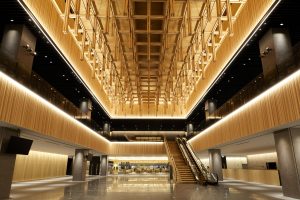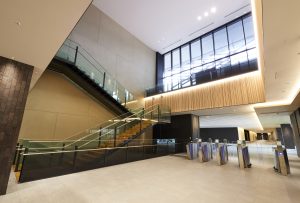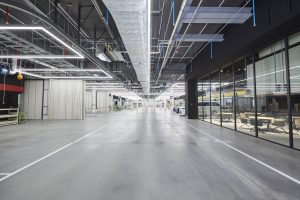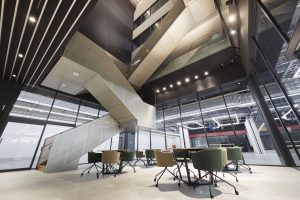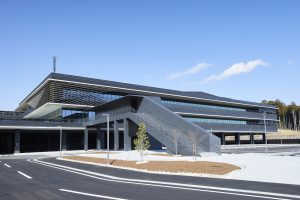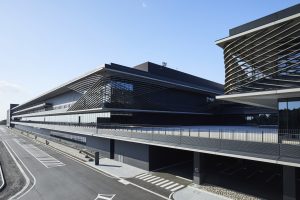Shimoyama: Toyota’s development cradle for making ever-better cars
- Official opening of the Toyota Technical Centre Shimoyama R&D facility
- 650-hectare site includes high-speed test track and routes replicating road types from around the world
- A new development base for Lexus and Gazoo Racing
- Facilities also include a Visitor Building for work with partners and suppliers and an Environmental Learning Centre
Toyota Motor Corporation’s new R&D facility, the Shimoyama Toyota Technical Centre, was officially opened last week, marking the completion of a six-year construction project.
Located in a mountainous area between Toyota City and Okazaki City in Japan, the centre will drive vehicle development, principally for new Lexus and GR (Gazoo Racing) models, supporting Toyota’s mission to build ever-better cars. It is also a place where the roads will be used to refine both machines and the people and who make them. The design of the test tracks takes advantage of the natural terrain to include challenging bends and changes in elevation.
Construction began in April 2018, focusing on a central area of rural-style roads that was ready for use a year later. Development of the eastern section followed, with a high-speed test course and a specialised area which recreates road surfaces characteristic of different parts of the world, in use since October 2021. The centre has already been used for tuning and track-testing new models that are now being driven by customers around the world.
The western section of the site was the last to be completed and is now fully operational. This includes the Vehicle Development Building, which is the new business and development base for Lexus and Gazoo Racing. Emulating the look and feel of the pit garages at the Nürburgring circuit, it is a place where members from many different business functions, including planning, development, design, prototyping and evaluation, will work together, assessing vehicles on the test course and making improvements. Cutting-edge equipment will be used to promote agile development, integrating digital technology with physical car manufacturing techniques.
The western area is also home to the Visitor Building, a venue for creative collaboration with business partners and suppliers. This will also provide an open space for innovation, encouraging new ideas through the kind of close interaction with cars that only a dedicated development centre can provide.
Maintaining and managing the natural environment was a prime consideration during the centre’s development. This included preserving the original trees and greenery approximately that cover approximately 60 per cent of the 650-hectare site as well as creating new green areas.
The Environmental Learning centre in the eastern section of the site will be used as a venue for engaging with local communities. Toyota will continue to co-operate with experts and local government and communities to conduct environmental conservation initiatives in the forests and the rice fields – the yatsuda – in the valleys that are part of the valuable local satoyama ecosystem. In so doing, the company will promote its ‘good neighbour’ principle, co-existing with communities and operating a facility that is in harmony with nature.
Speaking at the official unveiling ceremony on March 25, Akio Toyoda, Toyota Motor Corporation Chairman, said: “It has been nearly 20 years since conceptualisation of this project began. Around 3,000 people, including development members and test drivers from GR and Lexus, will drive, break and improve cars here. The more we drive and break cars, the ever better they become. Although Shimoyama is not a production plant, cars made there will be driven on every road in the world.”
Toyota Technical Centre Shimoyama outline
| Location | Toyota City (formerly Shimoyama Village) and part of Okazaki City (formerly Nukata Town) | ||
| Breakdown of area | Usage | Area | Percentage of total area |
| Facilities | 159.2 ha | 24% | |
| Roads | 7.1 ha | 1% | |
| Regulating ponds etc | 16.2 ha | 3% | |
| New green space | 81.8 ha | 13% | |
| Remaining forests etc | 386.5 ha | 59% | |
| Total land area | 650.8ha | 100% | |
| Business entity | Site development work: Aichi Public Enterprise Bureau Facility construction: Toyota Motor Corporation | ||
| Principal facilities | Central area: country roads Eastern area: high-speed and characteristic evaluation roads Western area: Vehicle Development Building and Visitor Building | ||
| Investment | Approx. 300 billion yen (£1.6 billion euro) | ||
| Number of employees | Approx. 3,000 (as of full operation, March 2024) | ||
ENDS

